Eduard 1/48 F4F-3S Wildcatfish
The Airplane:
Before the war, the Imperial Japanese Navy wasn't the only one concerned about the provision of air power in an island campaign across the Pacific. The U.S. Navy was also well aware that between the time the troops stormed ashore and the time an airfield could be constructed, the limited number of aircraft carriers could not remain in the vicinity of the invasion as targets for enemy ships, aircraft and submarines. Fortunately for the American Navy, the solution to this problem would come by the militarization of American industrial construction methods, which led the world for ability to handle large projects at a high rate of construction. Japanese military officers after the war would state that the American ability to quickly construct airfields and port facilities was the major reason why they lost the Solomons, where they were not able to complete one new airfield in total during the entire campaign up to the capture of Bougainville in October 1943.
In late 1941, however, this was all in the future, and the Navy was gravely concerned with the problem of air cover following invasion. Like the Japanese naval air force, the Bureau of Aeronautics decided that a floatplane fighter would be the solution. While the Japanese at first commissioned a designed-for-the-purpose fighter - the N1K1 Kyofu (Rex) - and then later adapted the Zero as the A6M2-N when the development of the N1K1 slowed, the U.S. Navy decided to adapt an existing fighter from the outset.
In early 1942, the Edo Corporation was contracted to convert one F3F-3 to a floatplane configuration as the F4F-3S. Unlike most Navy floatplanes, this did not have a centerline float and two wingtip floats - as did the A6M2-N - but was equipped with twin main floats. Faced with a need for such an airplane, the Navy proceeded to change a contract for 100 F4F-7 long-range recon Wildcats with Grumman to an additional 100 F4F-3s.
By the time the F4F-3S flew on February 28, 1943, the Navy's SeaBee construction battalions had proved their worth, and the program was canceled. The conversion took three months to complete. Initial flight tests revealed directional instability that resulted in the addition of a substantial ventral fin in addition to the smaller fins on the horizontal stabilizers. Top speed was reduced to 254 m.p.h., which was considered barely acceptable. The 100 F4F-3s on the production line were finished as land planes during early 1943 - the last Wildcats built by Grumman - and assigned to Training Command. This would prove fortunate for history, as the three F4F-3s ditched in Lake Michigan during the war and later recovered in the 1980s were from this batch, and now constitute the only three early Wildcats still in existence.
The Kit:
Over the years, modelers have been intrigued by the Wildcatfish. During the 1970s at least two adventurous souls I knew took the Monogram Wildcat, a pair of Monogram Kingfishers, added quite a bit of scratchbuilding ability, and kitbashed Wildcatfish models.
Back in 2001, Cutting Edge released a pricy conversion set to be used with the Tamiya F4F-4, with two large resin floats and resin fins and rudders, and white metal struts and beaching gear. This still required the modeler to convert the folding-wing F4F-4 to a stiff-wing F4F-3, which involved filling in the fold line and the outer gun bay in each wing, sanding those areas smooth and then rescribing all the engraved detail. Outside of one guy I know here in Southern California, Wildcat-loving modelers took a pass on the project at t hat point.
In 2002, Dave Schemel created an F4F-3 conversion set for the Tamiya Wildcat, that completely replaced the wing sub-assembly of the kit with a one-piece resin wing. This made a Wildcatfish project much easier.
Needless to say, at a cost of $26.00 for the Tamiya Kit, $50.00 for the Cutting Edge conversion and $40.00 for the Just Plane Stuff wing conversion, a modeler has to be extremely interested in the F4F-3S to step up to this project. Now that both The Cutting Edge conversion and the wing conversion sets are long out of production, with collector's prices approaching a few hundred dollars in total, such a project is impossible for all but the most committed modelers.
Fortunately, Hobby Boss came to the rescue with their F4F-3S Wildcatfish, allowing a modeler to do this one-off from a mainstream injection-molded kit. The kit provides an F4F-3 kit, with a fuselage sprue that has the wheel wells filled in, and a set of floats and struts on another sprue. Decals are provided to do the one and only F4F-3S.
And then this summer, Eduard released the “definitive” F4F-3 Wildcat. I received three F4F-3 Overtrees kits in the “Thank You”
box for doing the historical write-ups for my friends, and when another Hobby Boss kit showed up at the LHS, I decided I would create an F4F-3S that was as “definitive” as the Spitfire Vb floatplane I did earlier this year with an Eduard Spitfire Vb and the resin floats from the old Gartex Spitfire Floatplane kit.
It turns out, it's not that hard.
Construction:
This kitbash conversion is easy. There are two modifications that have to be made:
The Eduard F4F-3 kit needs to be modified with a cover for the wheel wells, which I made with .010 sheet styrene, cut in a circle and sanded to fit, then glued in position along with the kit gear doors.
The lower wing needs to have the shell chutes filled in, the fairings just aft of them removed, then sanded smooth and the rivet detail restored with a pounce wheel. Then a mounting hole for the pontoon main strut needs to be made in the lower wing. This can be done with reference to the Hobby Boss kit lower wing.
Fortunately, before I fully assembled the wings, I took a close look at the photo of the airplane in its final configuration and realized there were fairings like the early F6F-3 on the inner wing gun position. I fashioned these from sprue and attached them.
Other than that, one assembles the F4F-3 in accordance with the Eduard instructions, other than you do not need to worry about all the parts that go in the wheel well. The Hobby Boss pontoons and struts merely need to be assembled according to the instructions.
Painting:
Since I was doing the one-and-only prototype, which was very clean from the few photos available, I did not pre-shade the model, but instead did some post-shading so that the bluegrey/light grey camouflage is not completely monotone. I used my Tamiya mixture for Blue-Grey, and XF-80 Royal Light Grey for the main colors, then added in a bit of white to both to go back and post-shade.
Decals:
I didn't like the decals that came with the kit, so I used a set of Wildcat national insignia from Yellow Wings Decals. These were the only markings.
Final Finish and Assembly:
I painted the beaching gear, attached the wheels and then attached the beaching gear to the floats. I then gave the model an overall coat of Micro-Scale “Flat.” I did not weather the model further.
Overall Assessment:
The Hobby Boss Wildcat is far more accurate than the Tamiya Wildcat, when compared with the “definitive” Eduard kit, and you can make a nice model from the kit as it comes in the box. But the Eduard F4F-3 is a superior kit as regards detail and outline accuracy, so combining that with the Hobby Boss floats will result in a model that is superior in fine detail. Other than that, it's just fun to do a conversion every once in awhile and refresh the “old school skills” we used to have to use all the time to kitbash kits to get an accurate model. Any modeler should have no difficulty at all with this kitbash. A modeler interested in “what if” models could have a lot of fun making the floatplane fighter that never went to war with this kit.
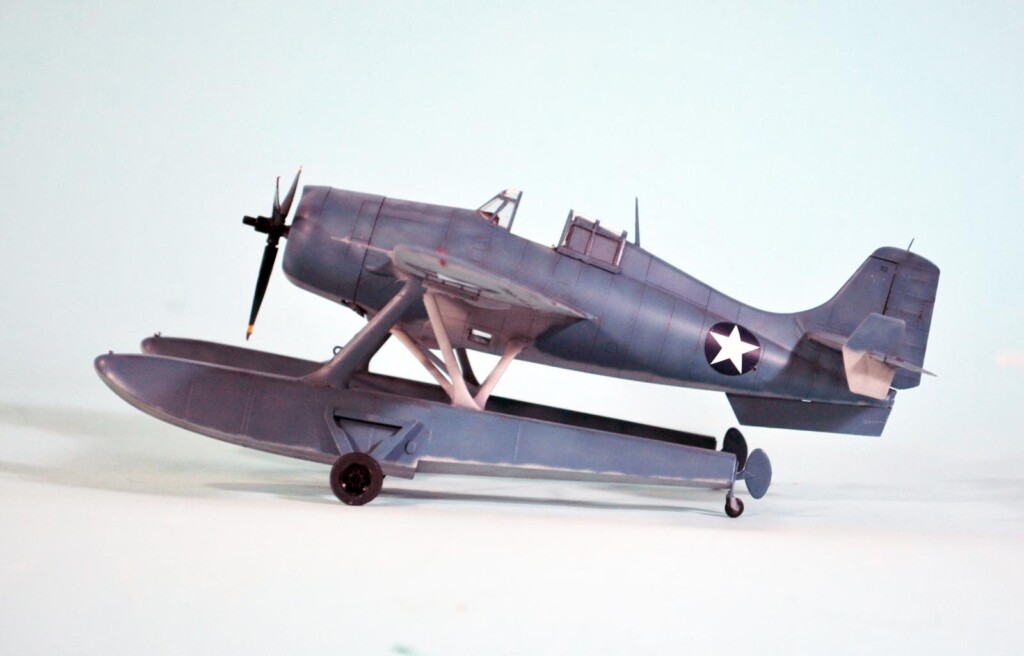
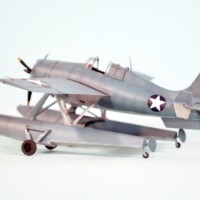
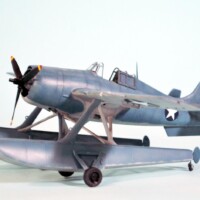
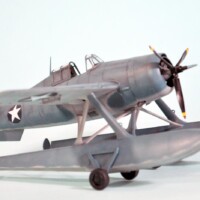
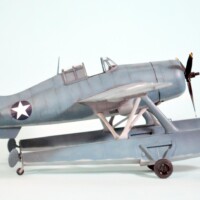
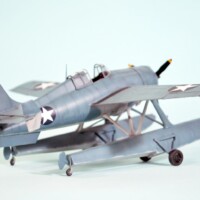
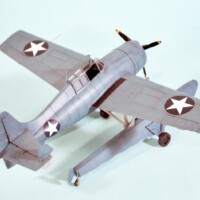
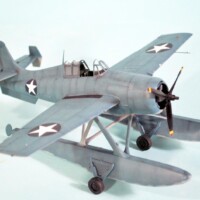
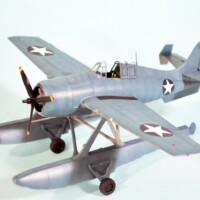
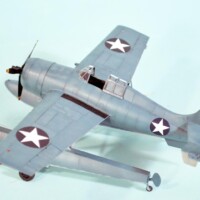
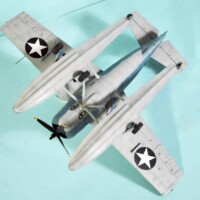
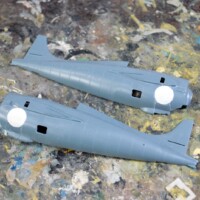
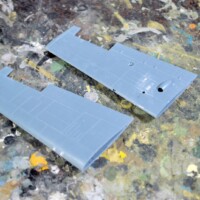
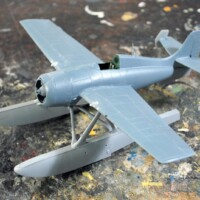
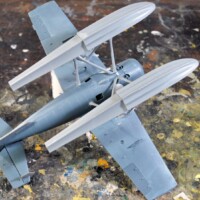
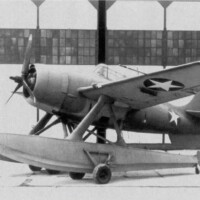
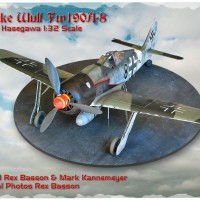
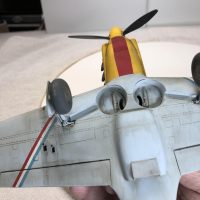
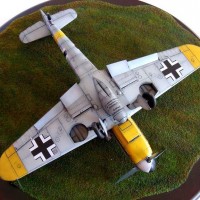
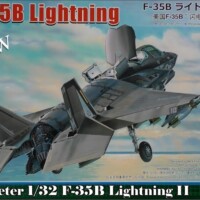
Interesting conversion.
This Wildcatfish looks really great, Tom @tcinla
Being unaware of its existance, your article is even more interesting to read.
Thanks for sharing.
Excellent kit bashing, a wonderful result and a great article, Tom!
A truly unique kit of a rare version. I like it a lot, even more so because it’s scratch work!
It's kit-bashing, @holzhamer, lower on the achievement ladder than scratchbuilding.
True @tcinla
But you’re somewhat modest in your observation Tom, because there is some scratch work involved
All in all a great project imo
Nice work, Tom. Some of your best paint work, in my opinion.
Coming from someone who paints as well as you do, I will take that as a Very Serious Compliment Indeed. Thanks!
Thanks, Tom.
I can only imagine how bad the climb rate was on this one….. Nice work, Tom. It is fun to do stuff like this every so often.
This is really cool- might have to try this myself seeing that you have blazed the trail. Thanks for sharing!
@tcinla, That's interesting and unique Tom. I enjoyed the history backstory and the model!
Wow, what an original build, I love a good kit bash and you've done yours so so well.
Cool & informative build! Thanks you for the history lesson!
Nice to see this built, looks great, nice write up too. Go EDO floats, I worked for EDO back in the eighties.
That's a lovely little build, and I think I might have to follow your lead! It will definitely look good, parked nose to nose with a 'Rufe'!
And Eduard is bringing out their Rufe in March. If it's anything like the A6M2 and the A6M3 Model 32, it will be amazing.
Nicely done Tom, and just looking at her screams slow as hell. Nice paint job you did on her, I like it a lot.
After all the countless models you have built over the years, this one belongs in your top ten masterpiece collection, TC @tcinla.
Bravo.
Looks great Tom. I've passed up a Wildcatfish kit several times, but since I've recently started a Wildcat binge, I may need to look for one!
Your kit bashing work looks great. I built the Tamiya F4F-4 and always wanted to do a Guadalcanal F4F-3 stuck in the mud diorama. I'm glad I "held out" as in not buying the other brands. Your comparison info helped me decide on the Eduard -3.